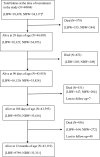Risk of postneonatal mortality, hospitalisation and suboptimal breast feeding practices in low birthweight infants from rural Haryana, India: findings from a secondary data analysis
- PMID: 29934384
- PMCID: PMC6020937
- DOI: 10.1136/bmjopen-2017-020384
Risk of postneonatal mortality, hospitalisation and suboptimal breast feeding practices in low birthweight infants from rural Haryana, India: findings from a secondary data analysis
Abstract
Objectives: Low birth weight (LBW) is a risk factor for neonatal mortality and morbidity. It is important to examine whether this risk persists beyond neonatal period. The current secondary data analysis aimed to examine association of birth weight with mortality, hospitalisation and breast feeding practices during infancy.
Design: Data from a large randomised controlled trial of neonatal vitamin A supplementation (Neovita) trial were used. Log binomial model was applied to assess association between birth weight and mortality, hospitalisation and breast feeding practices.
Setting: Rural Haryana, North India.
Participants: Newborns recruited in the primary intervention trial that aimed to evaluate the effect of single-dose oral vitamin A supplementation on mortality in the first 6 months of life.
Results: We recruited a total of 44 984 infants, of which 10 658 (23.7%) were born LBW, that is, birth weight less than 2500 g. In the neonatal period, LBW babies had four times higher risk of mortality (relative risk (RR) 3.92; 95% CI 3.33 to 4.66) compared with normal birthweight babies. In the postneonatal period, the risk was two times higher (RR 1.92; 95% CI 1.71 to 2.15); even higher in those with birth weight <2000 g (RR 3.38; 95% CI 2.71 to 4.12). The risk of hospitalisation in the neonatal period and postneonatal period was (RR 1.86; 95% CI 1.64 to 2.11) and (RR 1.13; 95% CI 1.05 to 1.21), respectively. LBWs were at increased risk of breast feeding initiation 24 hours after birth (RR 1.64; 95% CI 1.45 to 1.81), no breast feeding at 6 months (RR 1.34; 95% CI 1.23 to 1.46) and at 12 months of age (RR 1.24; 95% CI 1.18 to 1.30).
Conclusions: LBW babies, especially those with birth weight of <2000 g, were at increased risk of mortality, hospitalisation and suboptimal breast feeding practices during entire infancy and therefore require additional care beyond the first 28 days of life.
Trial registration number: NCT01138449.
Keywords: India; breast feeding practices; care and support; extended home visitation; hospitalisation risk; infant mortality; low birth weight; postneonatal mortality.
© Article author(s) (or their employer(s) unless otherwise stated in the text of the article) 2018. All rights reserved. No commercial use is permitted unless otherwise expressly granted.
Conflict of interest statement
Competing interests: None declared.
Figures


References
Publication types
MeSH terms
Substances
Associated data
Grants and funding
LinkOut - more resources
Full Text Sources
Other Literature Sources
Medical
